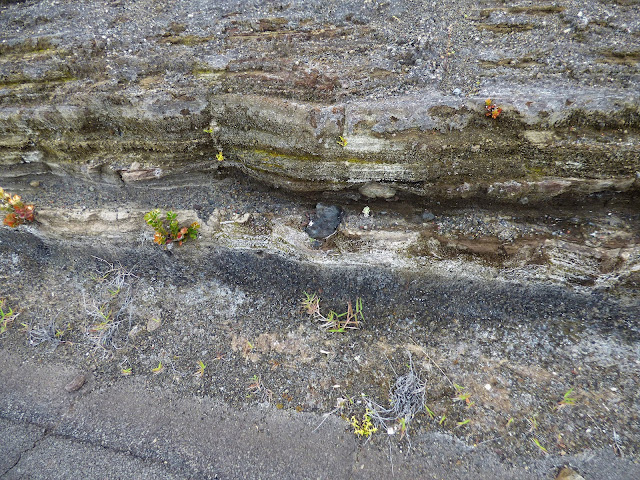 |
| Pele's Hair collected near the edge of Kilauea Caldera |
First off, the stuff in the first two pictures. These fibers are found around the summit area of Kilauea, and in protected hollows they can accumulate in large masses. It's called Pele's Hair, and it's made of natural volcanic glass, otherwise known as obsidian. Glass is not usually associated with basalt in the minds of most people, but glass can form around any lava that cools so quickly that crystals can't readily form. This odd feature develops around spattering edges of lava lakes like that which currently resides in the crater of Halemaumau. As globs of liquid are thrown into the air, some of the liquid trails behind as a thin fiber, which then breaks off and floats away in the turbulent hot air currents. If you visit the Big Island, you can usually find some near the Jagger Museum on the crater rim.
 |
| Reticulite from Kilauea Caldera |
 |
| Close up of reticulite from Kilauea |
A closer look reveals that these are layers of volcanic ash and scoria, the smaller particles that are associated with explosive eruptions, the kind we expect to find on the slopes of a Mt. St. Helens or a Mt. Shasta, the stratovolcanoes found on continental landmasses near subduction zones. What was going on here? The layers are more than 30 feet thick, and have been named the Keanakāko‘i Tephra.
 |
| Keanakāko‘i Tephra partially covered by a 1983 basalt flow. |
It's clear that what we get taught about basaltic lava is not the entire story. Sometimes basalt erupts violently, and as such it can be exceedingly dangerous. An eruption in 1790 killed several hundred Hawaiian warriors on the eve of a major battle, and the event changed Hawaiian history, as the tragedy was seen as the judgment of the gods. These deposits were once thought to be the results of the 1790 eruption, but it turns out that they include dozens of explosive eruptions that took place between about 1500 and the early 1800s.
 |
| Exposures of the Keanakāko‘i Tephra on the margin of the Kilauea Caldera. A 1983 basalt flow can be seen below on the right. |
What caused this explosive activity? In a word: water. When rising magma encounters groundwater, the water can flash to steam, causing intense explosions. Apparently the caldera collapsed to a depth great enough to reach the regional water table, and huge explosions ensued. Something like this happened at Kilauea in 1924 (see the picture below), but the massive explosions totaled only about 1% the volume of the 1790 and earlier eruptions. There have been some seriously dangerous eruptions throughout time on this volcano.
 |
| 1924 eruption of Kilauea Caldera, courtesy of the USGS and Bishop Museum |
And that brings us to the strange circles of the mystery. In 1924 some huge blocks were thrown out of Halemaumau crater and were thrown a thousand or more meters. When they landed, they produced bowl-shaped craters. One of the biggest from 1924 weighed 8 tons, and can be seen in the picture below.
The evidence of 300+ years of explosive eruptive activity around Kilauea is sobering. Such eruptions have the potential to do serious damage to surrounding communities around the caldera and in the Puna District to the east. Current research is seeking to better understand the cycle of activity surrounding these periods of violence.
It was a real privilege to explore the flanks of Kilauea Caldera with Don Swanson, Tina Neal, and Frank Trusdell of the Hawai'i Volcano Observatory during my visit to the islands last week. It was a fascinating learning adventure. More stories to come!







2 comments:
Great post. Love the mystery format!
I agree, really interesting post. Great photos too :-)
Post a Comment